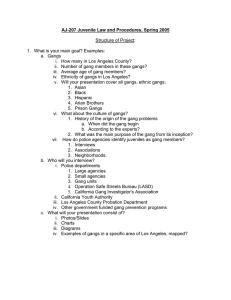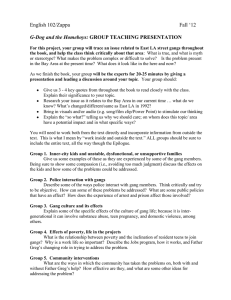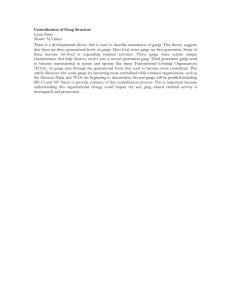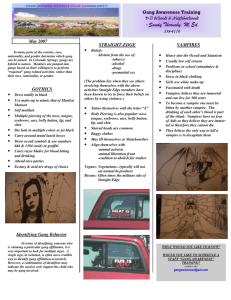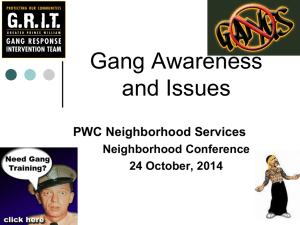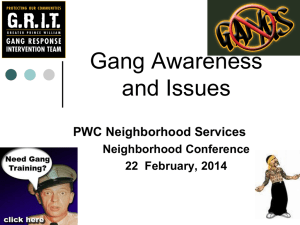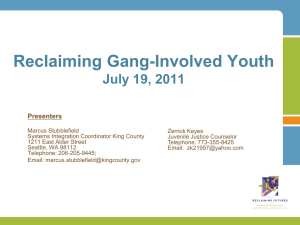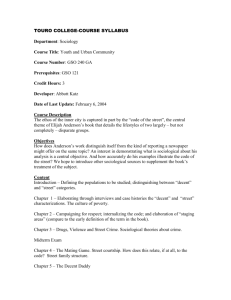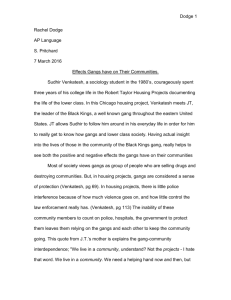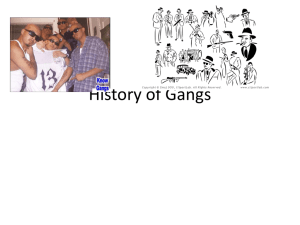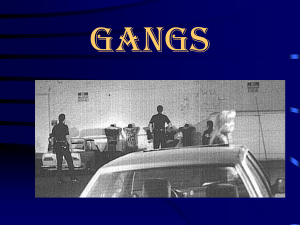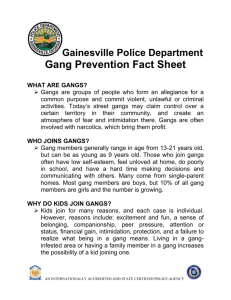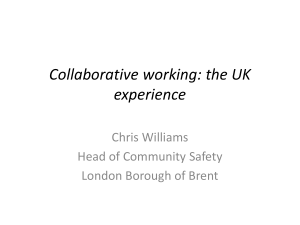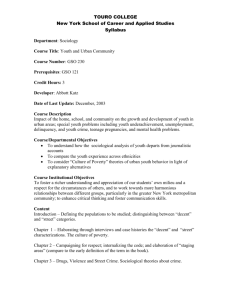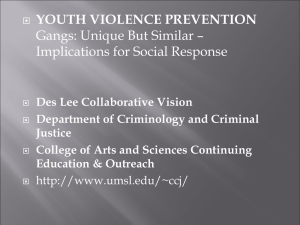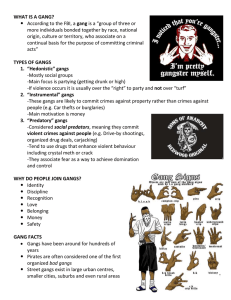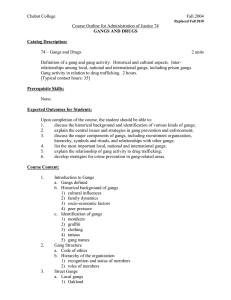OCT 1111: SNYDER – “LOS ANGELES STREET KIDS: NEW
advertisement
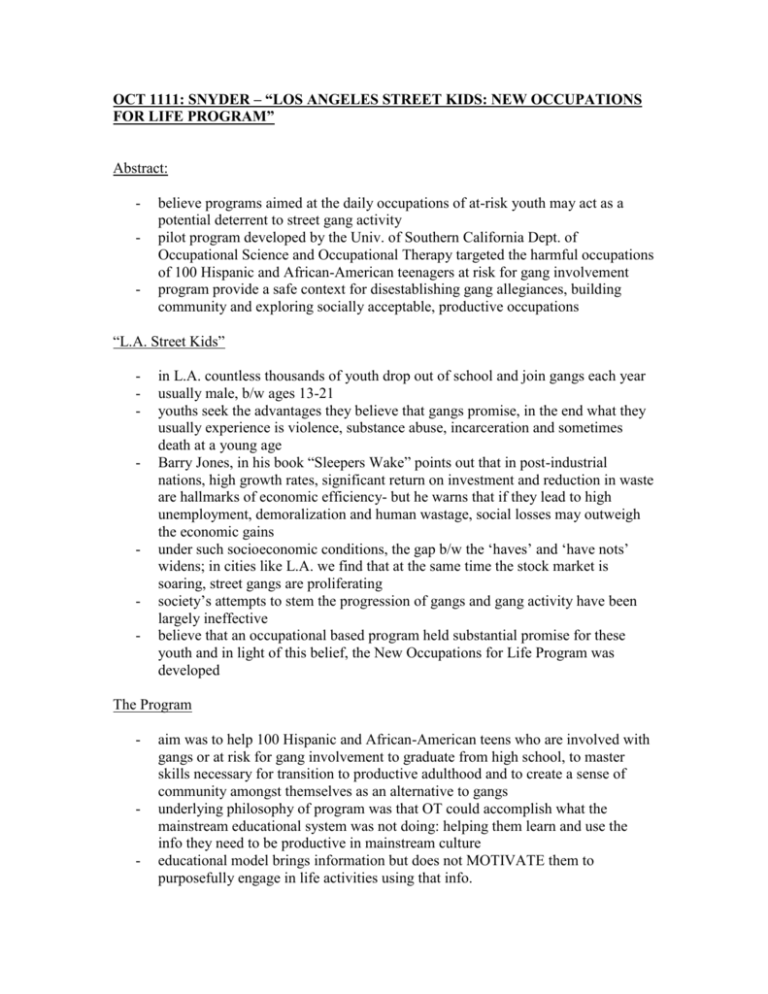
OCT 1111: SNYDER – “LOS ANGELES STREET KIDS: NEW OCCUPATIONS FOR LIFE PROGRAM” Abstract: - - believe programs aimed at the daily occupations of at-risk youth may act as a potential deterrent to street gang activity pilot program developed by the Univ. of Southern California Dept. of Occupational Science and Occupational Therapy targeted the harmful occupations of 100 Hispanic and African-American teenagers at risk for gang involvement program provide a safe context for disestablishing gang allegiances, building community and exploring socially acceptable, productive occupations “L.A. Street Kids” - - - - in L.A. countless thousands of youth drop out of school and join gangs each year usually male, b/w ages 13-21 youths seek the advantages they believe that gangs promise, in the end what they usually experience is violence, substance abuse, incarceration and sometimes death at a young age Barry Jones, in his book “Sleepers Wake” points out that in post-industrial nations, high growth rates, significant return on investment and reduction in waste are hallmarks of economic efficiency- but he warns that if they lead to high unemployment, demoralization and human wastage, social losses may outweigh the economic gains under such socioeconomic conditions, the gap b/w the ‘haves’ and ‘have nots’ widens; in cities like L.A. we find that at the same time the stock market is soaring, street gangs are proliferating society’s attempts to stem the progression of gangs and gang activity have been largely ineffective believe that an occupational based program held substantial promise for these youth and in light of this belief, the New Occupations for Life Program was developed The Program - - - aim was to help 100 Hispanic and African-American teens who are involved with gangs or at risk for gang involvement to graduate from high school, to master skills necessary for transition to productive adulthood and to create a sense of community amongst themselves as an alternative to gangs underlying philosophy of program was that OT could accomplish what the mainstream educational system was not doing: helping them learn and use the info they need to be productive in mainstream culture educational model brings information but does not MOTIVATE them to purposefully engage in life activities using that info. - - - - this population generally embraces information through “learning by doing” and OT may be an important complement to educational programming b/c it emphasizes motivation and doing, thus giving participants the opportunity to benefit from new life experiences at-risk youth attended an educational program at alternative education school sites and were not allowed to dress in gang colours; began to explore identities other than street identities at each site, the intervention was provided twice weekly for six weeks, each session was two hours in length following evaluation prd, the “action-oriented” phase of the program commenced program focused on: social communication and socialization (making friends/joining clubs); prevocational training and employment readiness; resource awareness (transportation/health care); community building; self-management (budgeting/cooking); enhancement of self-esteem and improving attendance in school to achieve diploma these areas were addressed in the context of a number of different activities documented the progress of the students after each session immediate verbal and written feedback from teachers, administrators and students through a post-program questionnaire were positive regarding the experience and impact of program; feedback gathered one month after the end of the program was also positive but follow-up research on the life progression of the participants have not yet been conducted Analysis of the Therapeutic Process - - - - - the intervention employed seemingly mundane occupations including games, food preparation, crafts and drama; however, these were used to create an essentially transformational and emergent social process they propose that through this process, gang members and those at-risk were afforded the time and space in which to rethink their lives, to act and interact with one another in new ways, and to experience a new “mode of being” in other words, they were provided opportunities to change their “images of themselves, their place in the world, their goals and their capacities” through OCCUPATION rather than being trivial/mundane, playful activities that are separated form the realities of life are potent vehicles for reflexivity, social process, crisis resolution and adaptation by addressing occupations and providing the opportunity for replacing them with others which are more healthy, safe, productive and socially acceptable, they believe positive change occurred which may be sustainable in the long term

